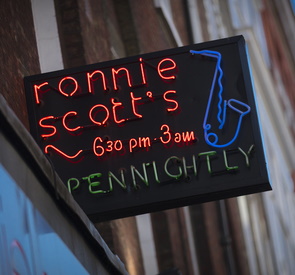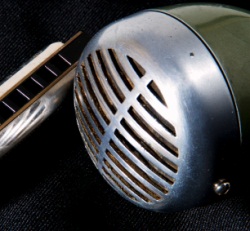Soul Limbo – Split Rivitt (Part 3)
We respectfully dedicate these pages to the friends and family of Barney Jeffrey 1958-2008
Split the bill
‘We did start a studio album together, but I wasn’t happy with what was going on so I walked out. They said they’d produce it themselves. I told them, you’ll see what happens, knowing full well they were unaware of all the pitfalls. Mark ‘Harpdog’ Hughes also played Chromatic. He was a normal kind of guy. Probably the quietest and most sensible band member. My studio notes show he was playing through a Shure Echo microphone. I think we added more harp on top and bounced it all down. I seem to remember asking him to harmonise and layer it. We were aiming at our own wall of sound. I think the end result stands on its own merit without impinging on the original.’
‘The track never truly got the exposure it deserved because the distributor, Pinnacle, got into financial difficulty. But it was on BBC Radio 1’s A list and got a lot of airplay. In fact it charted briefly in the top 20. I don’t know how the track was chosen originally. I have always been a big Booker T. fan, so maybe I had something to do with it. Anyway I love off-the-wall stuff. I once recorded the Dambusters Theme with a Punk Band and tried to sell it to the Germans. It didn’t get very far.’
 ‘In those days Ronnie Scott’s would put non-jazz acts on upstairs. Split Rivitt played there on at least one occasion. While rehearsing for their gig around 6pm, UK jazz icon George Melly overheard them and is quoted as saying, ‘I wandered upstairs to find Split Rivitt, all looking about 12 years old, are having a sound check. I learn that the drummer is Humphrey Lyttelton’s son. This information doesn’t make me feel younger at all.’
‘In those days Ronnie Scott’s would put non-jazz acts on upstairs. Split Rivitt played there on at least one occasion. While rehearsing for their gig around 6pm, UK jazz icon George Melly overheard them and is quoted as saying, ‘I wandered upstairs to find Split Rivitt, all looking about 12 years old, are having a sound check. I learn that the drummer is Humphrey Lyttelton’s son. This information doesn’t make me feel younger at all.’
‘Humphrey Lyttelton himself is quoted in the Daily Express’s William Hickey column, December 29th 1979, as saying, ‘I’d be a liar if I said it was my kind of music, but I’d have been outraged if David had done something really dreadful like becoming a City business tycoon.’
Post Script
Esteemed harp guru Pat Missin kindly dropped his recollections of the band through the Harp Surgery letter box. He writes, ‘I saw them live a couple of times supporting Dr Feelgood around 1980 or so. They were a great band, but somewhat lacking in stage presence and didn’t really win over the Feelgood audience. I believe Mark Hughes gave up the harmonica in favour of the saxophone, then gave up music completely. A real waste, in my opinion. Mark Hughes was one of the first harp players I heard really pushing the stylistic envelope. It’s hard to believe that someone of his abilities could just give up and vanish.’
So how did Harpdog Hughes finish the job?
Grab your C harp and check out the Split Rivitt record. We’re playing cross harp in the key of G. The track comprises two repeated sections, a middle eight and an outro section. “..He was playing through a Shure Echo microphone…we added more harp on top and bounced it all down”We’re going to look at the middle eight and outro. Think Pub Rock power blues harp, think Caribbean rhythm, think live at The Hope & Anchor circa 1980, dig in and get ready to groove. And don’t fret over the tone or any inflections on the recording. As Peter Shertser of Red Lightnin records explained, the harp track was multi-layered in a bid to achieve a new ‘wall of sound’ for UK R&B.
Here’s the middle eight.
Middle Eight – Marimba Section
The guitar takes the marimba line while the harp provides a separate harmony line.
2D….. 3D’..3D 4B..4B..4B..4B 3D 3D’ 2D
3D’..3D 4B..4B..4B..4B 4D 3D 2D
3D’..3D 4B..4B..4B..4B 3D 3D’ 2D
3D’..3D 4B..4B..4B..4B 4D 3D 2D
3D’..3D 4B..4B..4B..4B 3D 3D’ 2D
3D’..3D 4B..4B..4B..4B 4D 3D 2D
3D’..3D 4B..4B..4B..4B 3D 3D’ 2D
Final stretch
Here’s the section from the Split Rivitt recording
And now let’s finish the job
1D..1D 2B..2D 2B..2D
1D..1D 2B..2D 4B 3D..3D’..3D 4D..5B..4D 5B..6B..5B..4D
1D..1D 2B..2D 2B..2D ~3D..4D..3D..2D ~3D.. 4D..5B 5D..5B..4D..5B 3D..3D’..2D..2B
2D 2D”..2D’..2D”..1D 2D 2D”..2D’..2D”..1D 2D..2D 2D”..2D’..2D”..1D 2D”..1D..1D
2D 3D 4B 4D’ 4D 4D’..4B 3D 2D
6B……. ~6D 7D 7B..7D..6D 6B 5D 4D 4B
~3D 4D 5B 4D 5D 4D ~4D 4B
~3D..3D’ 2D..2D..2D” 2D”..2D’..2D”..1D 1B..1D
2D ~3D..4D..3D 2D..2D ~3D..4D..3D
2D..2D ~3D..4D..3D 2D..2D 2D”..2D’..2D” 1D 2D
 And that;’s all there is to it. We hope you’ve enjoyed our trip down memory lane. If you’d like a one to one lesson on this or any other aspects of diatonic harmonica playing contact the Good Doctor here. You can also find out more about Split Riviott in our bonus archive pages.
And that;’s all there is to it. We hope you’ve enjoyed our trip down memory lane. If you’d like a one to one lesson on this or any other aspects of diatonic harmonica playing contact the Good Doctor here. You can also find out more about Split Riviott in our bonus archive pages.
And there’s more…
For more information about Split Rivvit, visit our unique Split Rivitt Archive here.

